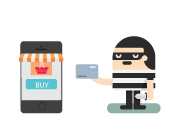The last installment in our series on types of card fraud will focus on Identity Theft and its connection with online card fraud. Identity Theft related card fraud is one of the most common sorts of fraud to affect e-commerce businesses in Brazil. This is not a surprise when taking into account that an alarming 49% of Brazilian consumers have been victim to some type of card fraud in the past five years. The country’s high rate of card fraud puts it in second position in the global ranking of fraudulent countries, only behind México.
Identity Theft and Card Fraud: Similarities and Differences
What is Identity Theft?
Identity theft is characterized by the theft of someone’s personal information and further use of such data to obtain economic gain. Fraudsters can get access to data such as IDs and social security numbers, birth dates, bank account and card details. They then proceed to use the stolen data for fraudulent transactions assuming the victims’ identity.
The stolen information can be obtained from different sources, including phishing tactics, spyware software, social media accounts or even through old bank statements thrown away without proper care. The stolen data can be used to gain access to victims’ bank or credit card accounts or to open new accounts.
What is Card Fraud?
Typically, card fraud refers to the use of stolen credit card information to carry out unauthorized purchases, mostly on online stores. Naturally, it also happens outside the digital world. For instance, a pickpocket can use the stolen card in traditional businesses, such as retail shops or restaurants. However, with the extended use of EMV cards, which require a PIN to complete a transaction, card-not-present fraud becomes more and more frequent.
Main Difference Between Identity Theft and Card Fraud
As we can see from the descriptions above, these two crimes are not the same. While card fraud can be a part of Identity Theft, the latter can be a lot more damaging to the victim. The primary difference between them is that credit card fraud usually affects one account. While the Identity Theft can lead to more serious credit damage, as the thief can open several accounts and lines of credit under the victims’ name.
How Can E-commerce Businesses Protect Themselves?
Every type of card-not-present fraud, such as friendly fraud, card testing fraud and even identity theft can cause a huge financial impact on e-commerce businesses. Apart from having to cover the costs of payment processing and, in many cases, the delivery of the goods, merchants will also have to refund the purchase amount, pay a fee for processing the refund and will lose their merchandise.
While friendly fraud is harder to identify by a fraud prevention solution, as it usually is a real purchase made by malicious buyers, identity theft can be more easily prevented. An antifraud solution such as PagBrasil’s PagShield will make use of a variety of techniques to stop fraudulent card transactions derived from identity theft. PagShield’s state-of-the-art buying behavior technology is based on an intelligent self-learning algorithm designed for the Brazilian market and its particularities and can help merchants selling in Brazil to reduce their fraud rates and consequently improve their profit margins.



Comment
[…] didn’t follow the rules of the contracts established with the card acquirers. Fraud, especially identity theft and friendly fraud, is often the cause in the first scenario. It can also happen due to incorrect […]